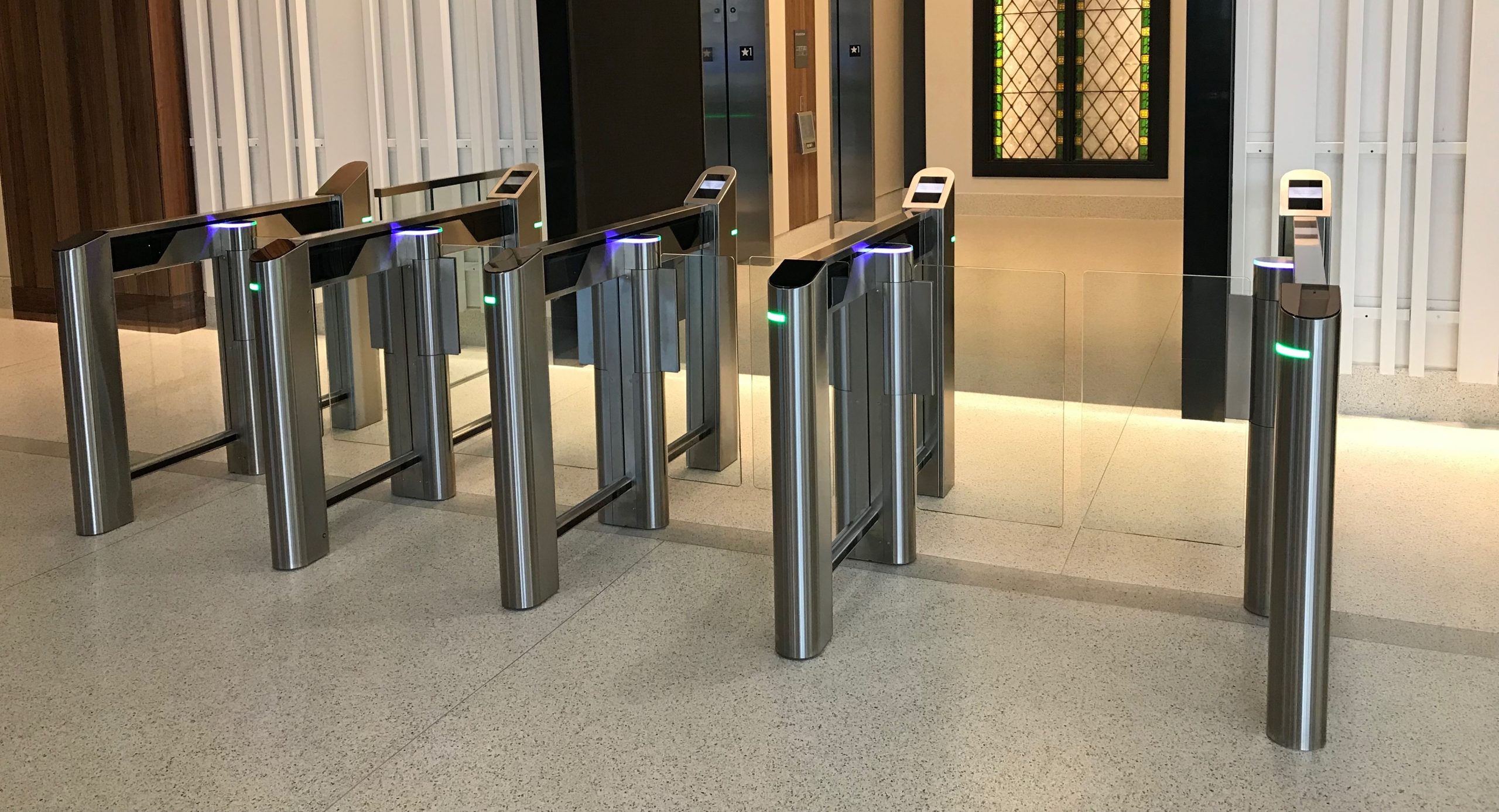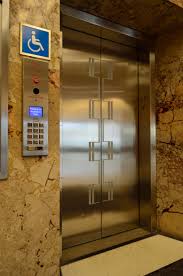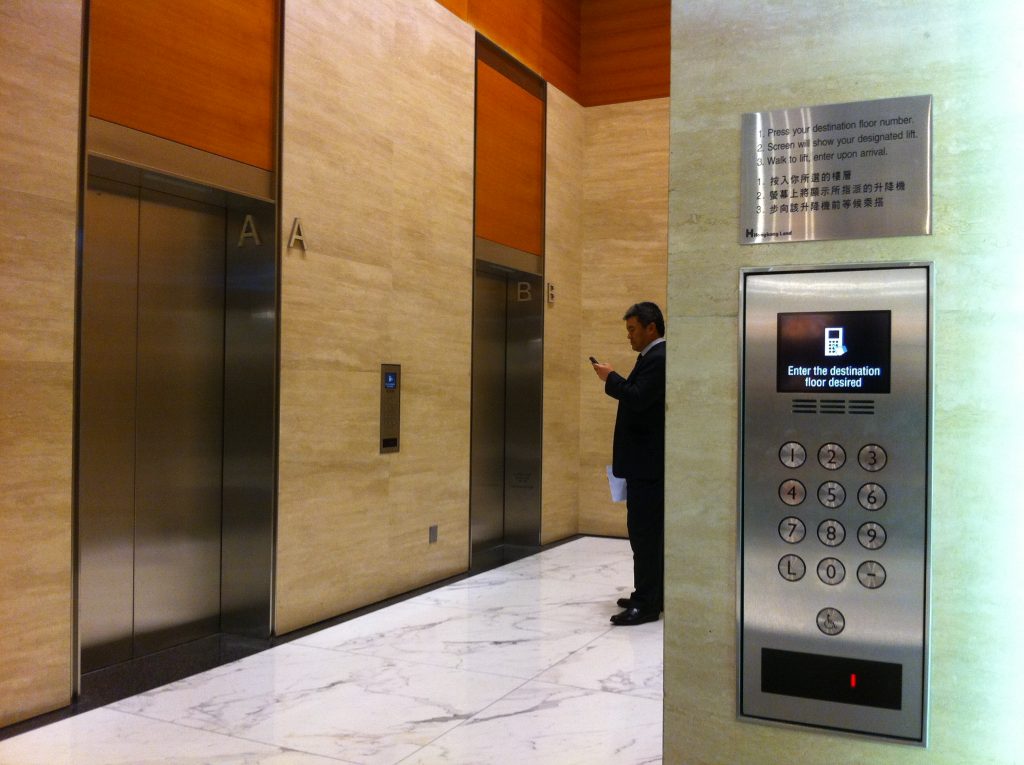
Before we look at the impact, if any, that Destination Dispatch Technology has had on energy saving, let’s first have a look at what this actually is.
Destination dispatch is a way of optimizing elevator travel to reduce wait and travel times. Passengers are grouped by their destinations so that people traveling to the same floor ride in the same elevator. This reduces the number of stops the elevator needs to make, which lowers the amount of time people spend riding and waiting for their floors.
Passengers can indicate their destination floors by tapping a keypad or touch screen or using a proximity card in the lobby. They are then directed to an elevator that is going to be traveling to that floor. It may or may not be the next elevator that will be arriving in the lobby.
In a full configuration, destination panels are located on every floor. There are no floor buttons to push inside the elevator, but there are still buttons that can be used to open and close the doors and to summon help in the event of an emergency. Handicap mode is supported in a full configuration. This is the most common type of configuration.
In a hybrid configuration, destination panels are only located on some floors. Other floors have up and down call buttons. There are floor buttons inside the elevator. Handicap mode is generally not supported in a hybrid configuration.
Destination dispatch is becoming popular for several reasons. It avoids unnecessary floor stops, which reduces wait and travel times. It can improve efficiency and organize traffic in lobbies. Passengers with impaired mobility can have better accessibility since they can move in advance to a designated elevator.

So, what has been the energy saving impact?
The technology is impressive, but it is the noticeable, real-world results that are transforming smart elevators from exciting curiosities into high-growth wonders. Advanced destination-based elevator systems today can reduce individual passenger commute times by 20 to 30 percent. In one study of a 15-story office building, it was found that a destination dispatch elevator made roughly half as many floor-stops per trip compared with conventional elevators. This type of performance not only speeds people to their destinations, it also means half as many decelerations and door openings/closing. This translates into less wear and tear on the equipment, and lower energy requirements to run the elevators.
One popular analogy for explaining the difference between conventional and destination dispatch elevator systems is the contrast between taking a bus and a limousine. Both vehicles get you to your destination, but the limo is faster and knows exactly where you are going.
Other Smart Benefits
Efficiency is also a key benefit. Because destination dispatch elevators are so efficient, building designers understand that the total number of elevators can be reduced significantly without affecting service, leaving more usable and rentable floor space in new facilities. Recently, designers of a high-rise building in Fort Lauderdale, Fla. were able to reduce the number of elevators from nine to five. In older buildings, retrofitting with a destination dispatch elevator system can allow companies to increase office populations significantly while maintaining good levels of service.
Additional features can be built into the systems, such as the ability to designate elevators temporarily for special visitors, emergency use, freight or maintenance use. For example, the Virginia Mason Hospital in Seattle has a destination dispatch elevator system that makes it easy for personnel to take individual cabs out of general service for emergency or priority uses. The hospital is also equipped with a keypad at the operating room nurses’ station to call the cars when they need to move a patient. They have even programmed the elevator doors to remain open longer for emergency uses to allow gurneys, wheelchairs and stretchers more time to enter and exit.
Many destination dispatch elevator systems today now include handicap features that use voice and light signals to assist hearing or visually impaired passengers. If a passenger presses the handicap button on the central keypad, destination dispatch systems will assign fewer people to the car to allow room for a wheelchair and delay door closing to allow more time for entry and exit.

Into the Future
New human interface access control elevator systems combine destination dispatch technology with electronic identification to take efficiency, specialized service and access control a step further. Unlike simple card-access elevators that grant or deny access, these new access control human interface systems use electronic ID cards to access personal data and customize service. Once a person is identified using a badge, PIN code, key tag or other electronic device, the system assigns an elevator car that conforms to their specific needs.
For example, building tenants with disabilities do not have to push the handicap button because the system will automatically “remember” them and activate the special needs they require. VIPs may be assigned to special limited-access elevators. Equally important, the human interface system enables greater control over access to restricted floors when necessary. This elevator not only knows in advance where the passenger is going, it also knows who the passenger is and personalizes each trip accordingly.
The End Word
All new technologies require time to become mainstream realities as people go through yet another learning curve. Unlike most new products, though, destination dispatch and access control elevators typically require just one or two rides before people become familiar with centralized keypads and assigned elevator cars. For our Canadian readers who also own buildings and are considering installing these systems, consider contacting March Elevator Ltd for advice and prices.
